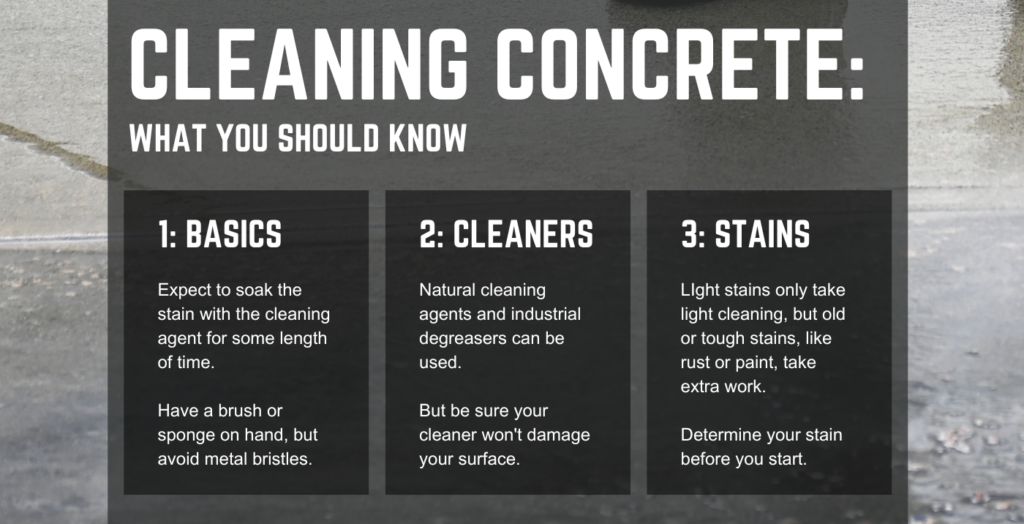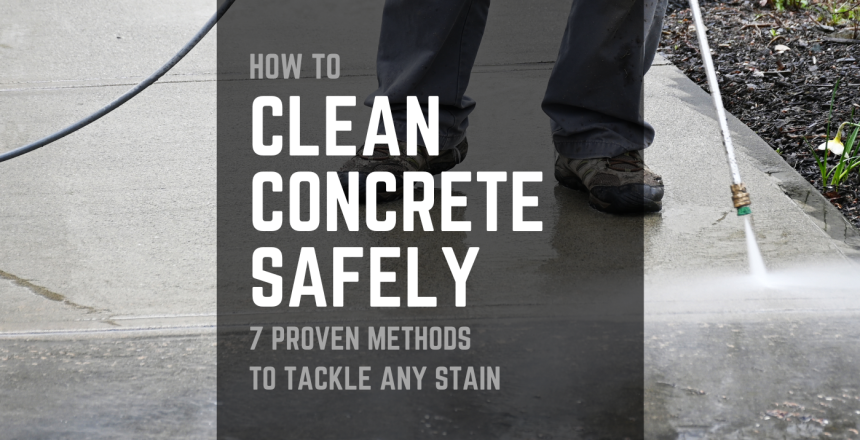Concrete provides incredible durability and versatility. Whether it’s a garage floor, an outdoor patio, or even countertops, properly installed concrete can last decades and look beautiful. But spills, messes, and nature can all leave nasty marks and stains.
Cleaning your concrete doesn’t have to be stressful, but you need to know how to clean concrete properly if you want to avoid damage or, even worse, permanent discoloration. And the key to proper concrete cleaning is understanding the science behind your concrete.
Why Does Concrete Stain?
Concrete is a mixture of several naturally occurring materials. That means that it’s porous, so liquids can soak into the material. That’s where stains start.
Stains come from organic materials (leaves, grass, animal droppings), as well as inorganic materials (oils, grease, chemicals). Some stains are more permanent than others, making them more of a challenge to remove. But that same permanence can be beneficial.
Bad Stains and Good Stains
Since chemicals can still affect concrete, even when cured, we can use its properties to create some incredible results. This is how concrete stains and concrete dyes work: they utilize concrete’s natural properties to change or enhance its color.
When applied evenly, concrete stains permanently change the color of a slab, usually with earth-tone looks. Concrete dyes, while not chemically reactive, soak into the concrete to create more vibrant colors and effects.
These two mechanisms are problematic when you didn’t intend to change the appearance of your concrete. Whether it’s a chemical reaction or a material seeping down into the pores of your concrete, accidental staining is anything but beautiful.
But, with the right tools and techniques, most bad stains can be reversed.
How to Clean Concrete Safely

The cleaning process you’ll need to use depends on the kind of concrete you’ll need to clean. Here’s what you need to know to clean your concrete without damaging the surface.
Cleaners and Detergents
While some unwanted stains can be cleaned with pressure washing alone (superficial stains and dirt accumulation, along with a few tougher stains), you’ll need some sort of cleaning agent or detergent to get out old or tough stains.
There are natural options, household detergents, and professional cleaners to choose from. Your choice depends on both your stain and your surface. Concrete with decorative finishes, for example, needs more gentle cleaning methods to maintain its finish. Driveway slabs are far less sensitive to cleaning agents.
Basic Cleaning Instructions
In every method, you’ll have a few basic steps that stay relatively the same:
- Soaking time: Almost every method will require some time to soak in the detergent or chemical cleaner. Depending on the stain and the strength of your cleaner, expect anywhere from 10 minutes to several hours for soaking.
- Scrubbing: Most cleaning methods require a soft-bristled brush, although a wire brush may be required in rare situations. Wire bristles should be a last resort, as they could etch the surface or leave metal flakes that could eventually rust and cause more stains.
- Washing and Rinsing: After scrubbing, you’ll need to rinse away any remaining soap, chemicals, and detergents. Pressure washing is great for outdoor spaces, while a simple mopping will work on indoor floors. You may need to repeat the cleaning process a few times for tougher stains.
Cleaning By Surface
In some cases, you’ll need to adjust your methods to keep the surface safe. Here’s what you should look for to make sure you don’t choose the wrong method for cleaning your concrete surfaces:
- Professionally stained concrete: use stone cleaners or Castile soap to maintain the finish without pulling the color.
- Polished concrete: mild soap and a mop can clean most polished surfaces.
- Sealed Concrete: Avoid any acidic or alkaline cleaners for minor stains, but strip the sealant coat for major stains and then reseal.
- Stamped or engraved concrete: Don’t use harsh cleaners or stiff-bristled brush to avoid damaging the surface.
- Concrete countertops: stick with dish detergent or a pH-neutral degreaser to maintain the sealant coat.
Now, if you’re dealing with stains on outdoor concrete with no special finishes, you might be good to go with something as simple as a pressure washer and a little liquid dish detergent.
Cleaning By Stain
Each type of stain is a little different, so choose your cleaning detergent and method to address your specific situation. We’ve included some of the most common stains below with tips on how to clean each one. Our list goes from easier stains to more difficult ones.
- Dirt and Lawn Debris: Sweep off the loose debris, then either pretreat with a mild detergent and pressure wash, or just pressure wash the surface.
- Food Grease: Cover the stain with laundry detergent, then cover with plastic wrap and seal with tape. Let it sit overnight, then scrub with a brush or sponge. Rinse completely clean.
- Pet Stains: Add some dish detergent and baking soda to a gallon of water. Pour over the stain and scrub. Use an oxygenated enzyme pet stain remover to eliminate any lingering odors or stains, then rinse clean.
- Bird Droppings: Much like pet stains, but may require more baking soda. Scrub with a soft brush or sponge, then rinse and dry. As an alternative for tougher stains, mix a small amount of hydrogen peroxide and ammonia together and apply to the stain and then scrub and dry.
- Motor Oil: Start by soaking up any excess oil with paper towels. Soak the stain with laundry detergent or a mixture of vinegar, washing soda, and dish soap for about 10 to 15 minutes. Wipe off the mixture or detergent, then rinse the area completely.
- Paint: Use trisodium phosphate cleaner (TSP) by soaking a dilution into the stain and letting sit for at least 30 minutes. Scrub with a stiff-bristled brush and rinse, then scrape any paint off with a plastic putty knife. Let the concrete dry. Apply paint thinner and scrape again. Repeat this process until the paint is removed. Note: The color may be permanent, depending on the age of the stain, but this process will minimize its appearance.
- Rust (new or minor stains): Clean with dish soap and water and then apply pure lemon juice. Let sit for 10-15 minutes. Scrub the stained area with a stiff-bristled brush or sponge. Repeat if needed, or try using vinegar instead.
- Rust (old or major stains): Use a commercial cleaner with oxalic acid, hydrochloric acid, or TSP in a 2:1 acid-to-water ratio. Soak the stained area and let sit for 5-10 minutes. Scrub with a stiff-bristled brush or sponge. Repeat if needed. Note: commercial cleaners and acids are dangerous, so follow safety precautions carefully.
Preventing Stains on Concrete
Once your concrete is clean, you can take some precautions to keep it from getting stained again. Adding decorative and protective finishes, as well as keeping some easy tips in mind, can help keep your concrete looking incredible for years to come.
Polish Your Concrete
A polished concrete floor helps keep liquid spills from soaking into the concrete, and it looks stunning. While some staining may still occur, it’s usually easier to clean up than raw concrete. This is a perfect option for indoor floors.
Seal Your Concrete
Adding a polymer seal coat is a less intensive process than polishing, and it provides a completely nonporous layer to protect your concrete from future stains. Your outdoor spaces benefit from extra protection from the elements as well. The one drawback is that you’ll need to seal your concrete every two or three years.
Clean Up Spills Quickly
Stains are caused by liquids seeping down into the concrete, so the longer the liquid sits, the deeper the stain will be. Most stains can be prevented by simply cleaning up spills immediately. Any superficial stains can then be cleaned up with a little mild soap and water.
Avoid Metal Cleaning Tools
Metal will rust on concrete if it isn’t caught soon enough. And since concrete retains water naturally, you should steer clear of cleaning tools that use metal as an abrasive. Metal-bristled brushes, steel wool, and metal scrapers can all cause issues.
Finish with Epoxy Coatings
If you don’t want to invest in the labor-intensive process of polishing your concrete, epoxy floors are excellent alternatives. You can find DIY kits, but professional installations are often longer lasting. These resin coverings offer fast and durable results, but they can delaminate with heavy use or improper installation.
Looking to Replace Your Concrete?
Unwanted concrete stains are unsightly, although they’re just cosmetic in most cases. But if your concrete is cracked, chipped, or falling apart, it might be time to replace it. Whether you want stained, dyed, stamped, or polished concrete, Brooks is ready to help. Make your next concrete surface stunning by giving us a call today!



